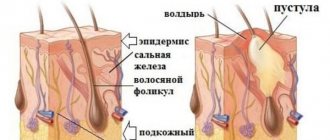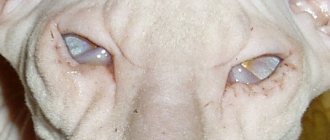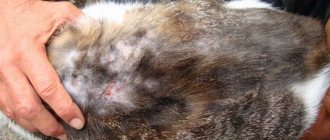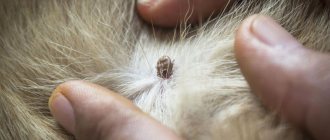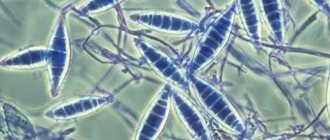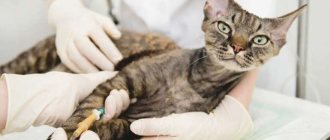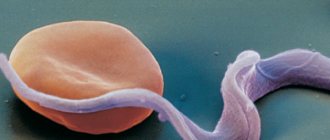- Cats
- General issues
The skin of cats is quite sensitive, so our pets itch very often, but be careful: healthy animals do not scratch if the cause of the itching is dust, sand or dirt. But if an animal constantly scratches the same place very strongly, to the point of redness and abrasions, then you need to think about the state of its health. One of the reasons for constant itching may be notoedrosis in a cat - acariasis, which is caused by microscopic mites.
What is notoedrosis, why does it happen in cats?
The causative agent of this disease is the tick notoedres cati. It is so small in size (only 0.15–0.45 mm) that it is simply impossible to see it with the naked eye (you can see how it looks enlarged in the photo). If you examine the bloodsucker under a microscope, you can see a round translucent body and a proboscis with which these parasites pierce the skin, penetrating it and laying numerous tunnels in its thickness.
Tick notoedres cati
Initially, these arachnids infect areas on the host’s head, then move to the neck, abdomen, shoulder blades and limbs. No animal is immune from infection with notoedrosis, or cat scabies. This is not affected by the time of year, gender, age, breed, or physiological state of the pet.
Risk group for notoedrosis
Notoedrosis is a parasitic and highly contagious disease. The causative agent is the microscopic subcutaneous mite Notoedres cati. It actively reproduces inside the dermis of animals.
At risk are primarily young cats aged 1 to 3 years. Animals weakened by certain chronic infections (leukemia or leukemia, immunodeficiency virus) are more often infected.
Subcutaneous mite Notoedres cati under a microscope
Biology of the parasite
The tick is not able to exist for a long time outside the cat. Under favorable conditions (high humidity and temperature 7–10 °C), it remains viable for no more than a decade. The parasite lives in a layer of skin rich in nerve endings. Therefore, the movement of arthropods causes unbearable itching in the cat.
recommended articles:
- Papillomas and warts in cats
- Why does my cat's belly go bald?
Females gnaw tunnels, tens of millimeters long, through which they climb to the surface of the skins. The insect lays eggs inside the passages and dies. 3–8 days after laying, the larvae hatch and, having reached 2–3 weeks, become sexually mature. The Notoedroz mite parasitizes cats of all ages and breeds. Transmission occurs through contact or through household items.
Female tick with oviposition
Spread of the disease
Outbreaks of notohedrosis periodically occur among stray cats, especially in cities where they feed and live in groups. The frequency of cases of the disease is not tied to the seasons and depends on a specific area. Veterinarians always know whether there are foci of notoedrosis in the area. Migration of cats in the spring and fights associated with procreation contribute to the spread of mange. The living conditions of animals in shelters and hotels also affect the incidence of notoedrosis.
Video: advanced form of notohedrosis in a cat
The subcutaneous mite Notoedres cati is contagious among cats of any age and breed. Susceptibility to invasion by ectoparasites is the same in domestic and yard animals. Kittens and young animals suffer from notoedrosis especially severely and die faster.
The main cause of the disease is direct contact with the skin of animals. Adult parasites crawl onto a healthy cat through the ears or nose. Ticks are also found on pet care items. Here they remain alive for one or two days and die if they do not find a new warm-blooded host. A cat infected with notoedrosis transmits the disease to all kittens in the litter. The overall incidence of head scabies in animals varies depending on the presence of the pathogen. Massive subcutaneous mite infestations in cats are now less common than 5–10 years ago.
Only organized veterinary control and the creation of more shelters will help reduce the number of cases of notohedrosis. In our country, unfortunately, the fate of street animals worries mainly volunteers. In countries where the number of stray cats is minimal, head scabies are rarely reported. For example, in the United States, animals can get notoedrosis in only two out of fifty states.
Symptoms of the disease
In young animals this disease is more severe. The severity of its course in this category of cats is due to the fact that due to the special elasticity and softness of their skin, bloodsuckers spread much faster and penetrate deeper into its thickness. The main symptom of cat scabies is severe, incessant itching, which appears due to the destruction of the epidermis by parasites and irritation of nerve receptors.
The animal's skin itches so much that, trying to relieve the discomfort, it scratches the itchy areas, injuring the lesions. This leads to the dermis thickening and folds and cracks appearing on it. Notoedrosis is also accompanied by:
- changes in behavior - a pet that is constantly itching becomes restless and sleeps poorly;
- complete or partial loss of interest in food;
- the appearance on the back of the nose, above the eyes, at the base of the ears of nodules and bubbles filled with liquid, which, when scratched, burst and become covered with crusts - these signs do not appear immediately, but as the pathological process worsens;
- hair loss on affected areas of the body;
- thickening of the skin;
- enlargement of the submandibular lymph nodes.
Gradually, the parasites spread to the cat’s neck, torso and paws. The affected skin cracks. Through wounds on it, pathogenic agents enter the pet’s body. The addition of a bacterial infection to the pathological process is indicated by the appearance of blisters with purulent contents.
Symptoms of head scabies
In the first week after a pet is infected with the pathogen of notoedrosis, there are no obvious signs of the disease. But the animal already senses parasites, although there are still only a few of them.
After a subcutaneous mite infestation, a cat:
- worries;
- demonstrates increased appetite;
- scratches ears and head;
- licks himself often.
By making passages in the lower layers of the skin, mites irritate the nerve endings and cause a feeling of severe itching. The ears are the first to be affected. The fur on them thins, and small reddish bubbles appear along the edges of the ears. While washing, the cat transfers ticks not only all over the head and neck, but also to the front paws. Infection of the hind legs and tail occurs during sleep, when the pet curls up. The stomach and back are the last to be affected by subcutaneous mites. But during the first month of the disease, its signs are noticeable only on the ears and head of the animal. This is a localized form of notohedrosis.
Hair loss on the ears and wounds from scratching on a cat's head are the first signs of notoedrosis
Later, changes in the surface of your pet's skin become more pronounced. Brittle gray crusts appear in places where female mites laid eggs and died. The surface of the skin thickens and deforms, folds form. The affected areas of the epidermis, where the parasites have left, become raw, red and inflamed. The infiltrate contained inside the skin forms papules. The fur thins out or falls out completely in areas where parasites are active. Dry skin causes dandruff.
Thickened skin with crusts indicates severe notoedrosis.
Despite a good appetite, the animal noticeably loses weight due to a decrease in the volume of fluid in the body. The cat scratches itchy areas more and more often and thereby injures itself. The wounds bleed, opening the gates for bacterial infection. If notoedrosis damages the skin around the nose and eyes, conjunctivitis develops and, in more rare cases, rhinitis. With an advanced disease, the front of the head is completely covered with a thick crust. Because of this, a sick cat practically cannot see and smells less clearly.
Without medical help, notoedrosis will lead to the death of the cat.
If the animal cannot eat the required amount of food, this leads to exhaustion, which aggravates the disease. At an advanced stage of scabies, purulent dermatitis develops. Ticks penetrate the submandibular lymph nodes, causing them to harden. This sign is characteristic of the generalized form of notoedrosis, when the entire body of the cat is damaged. If treatment is not started immediately, she will die.
Clinical picture
The disease develops gradually. The first symptom is itching, as active females, penetrating the skin, immediately begin to gnaw the passages to feed. There are no other external manifestations, but the cat is constantly itching at the site of parasite penetration. Sometimes papules appear at the site of mite penetration, but they are difficult to notice under the fur.
Constant scratching leads to skin injuries and partial alopecia. Gradually, if the wounds are not treated, a secondary bacterial infection joins acariasis.
Usually the first external symptoms become noticeable in the head area.
As the parasite invades new areas of the skin, the previously affected areas develop a characteristic lesion:
- the upper layer of the epidermis becomes thick and dry;
- Dense crusts appear in places where scratching and parasite penetration occur.
In advanced cases, skin symptoms are accompanied by signs of damage to the immune system: the lymph nodes closest to the site of parasite activity enlarge, and the temperature may rise. Without proper treatment, skin necrosis is possible, which can lead to sepsis and death of the animal.
What is cat scabies?
Cat scabies is an animal skin disease caused by parasitic organisms. The disease is caused by these types of ticks:
- Sarcoptes canis. The organisms cause pruritic scabies (sarcoptic mange). The locations of the lesions are different parts of the body. The disease most often affects dogs, but cases of infection in cats are also not uncommon.
- Notoedres cati. Mites cause head scabies (notoedrosis). This cat disease is one of a number of common diseases.
Important! The disease also occurs due to ear mites. Scabies in this case is called otodectosis.
Scabies mites under a microscope
Ticks that live in your pet's skin cause discomfort, which forces the cat to scratch the lesions. Symptoms of the disease become apparent 2-3 weeks after infection.
This is interesting: What to do if your cat is bleeding from the mouth?
Diagnostics in a veterinary clinic
Even if you manage to independently detect the presence of bloodsuckers, it is impossible to identify them at home. This can only be done by a veterinary clinic worker using special tools. To do this, a scraping is taken at the border of the affected and healthy skin: in the areas favored by the parasite, it has nothing to feed on, and it moves to neighboring ones. After this, the biomaterial is treated with an alkaline composition, which dissolves the crusts. Then it is placed between the glasses and after some time examined under a microscope.
Symptoms and diagnostic methods
The very first symptom of the lesion is severe itching, then areas of alopecia (bald patches), blistering rashes (papules), and crusts on the skin appear at the site of scratching. The disease begins in the dermis of the head, then spreads to the neck, forelimbs, and in rare cases, to the hind legs.
Without treatment, notoedrosis provokes such complications in cats as:
- purulent conjunctivitis;
- swelling of the eyelids;
- narrowing of the nostrils, followed by difficulty breathing;
- thickening, drying, cracking of the skin;
- addition of a secondary infection (viral, fungal, bacterial).
Since the tick reproduces only on cats, in dogs and people it provokes a local reaction to the parasite’s saliva in the form of itching, hyperemia (redness) at the site of the bite. All symptoms in dogs usually go away on their own within 30 days. At this time, they are carriers of ticks, dangerous to others (especially cats).
Notoedres cati is a microscopic life form, so it is impossible to detect the parasite on your own. This can only be done by a veterinarian based on:
- medical history (information about symptoms, possible contacts with affected animals);
- microscopy (examination of superficial scrapings from the surface of the skin);
- dermatohistopathology (study of the epidermis for the presence of mite fragments).
Notoedrosis is differentiated from:
- infection with ear parasites;
- dermatophytosis;
- demodicosis.
The doctor must also exclude the possibility of autoimmune dermatological pathologies, allergic reactions to insect bites, food, and other provoking factors.
Diagnosis of the disease and treatment
It is very important to exclude other diseases, the development of which is caused by subcutaneous mites (demodectosis, otodectosis).
To detect parasites, the veterinarian takes a scraping:
- The material is collected at the border of healthy and affected skin.
- The doctor carefully scrapes the skin with a scalpel or a special sharpened spoon until blood appears.
- The resulting particles are placed in a glass cup and filled with caustic soda (10% solution) for 3 minutes.
- After the material has softened, several small pieces are applied to a glass slide and examined under a microscope.
The diagnosis is made after pathogens are found in the scraping. Sometimes it is necessary to do this procedure again.
After making a diagnosis, the veterinarian writes a treatment regimen. First of all, an animal infected with a tick is isolated from other animals. In places covered with scabs, the wool is cut off. The crusts are carefully softened with chlorhexidine; in case of severe damage, you can wash the cat.
To confirm the diagnosis, a scraping is taken from the affected skin
First of all, it is necessary to destroy the pathogen. Antiparasitic parasites are used for this purpose. Stronghold is most effective for notoedrosis (it is dripped onto the withers twice, with a break of 4 weeks between treatments).
A day after applying the drops, aversectin ointment is applied to the areas of the skin damaged by the mite every 5 days (2-3 treatments in total). Wounds are also treated daily with sulfur ointment. Antihistamines are used to relieve itching.
Causes of the disease and routes of infection
A disease such as notoedrosis is caused by microscopic mites (from 0.2 to 0.45 mm). They are light gray in color and have a rounded body shape. Parasites bite into the thickness of the dermis, make passages in it, lay eggs, and feed on particles of the epidermis.
Ticks are quite hardy - without a food source they live up to 10 days.
An adult female lives 7 weeks, males die a little earlier. Females die immediately after laying eggs.
Cats become infected with parasites in the following ways:
- Through street shoes or wearer's clothing.
- In close contact with infected animals (mating, playing together, fighting, etc.).
- Through objects with which an animal suffering from notoedrosis has come into contact (combs, toys, bowls, bed, ammunition, etc.).
There are known cases where small kittens were infected with notoedrosis from their mother. If a cat is sick, the babies are taken away from her immediately after birth.
Notoedrosis is transmitted through close contact between animals
Treatment of notoedrosis in cats
Once notohedrosis is detected in a pet, it is isolated until it is completely cured. Before starting treatment you must:
- cut the hair around the lesions, which makes it easier to treat the affected areas of the skin;
- bathe your four-legged pet with pet shampoo to remove crusts and soften rough skin.
Information about treating feline mange:
| Features of the disease | Veterinary preparations used | special instructions | |
| Focal | Liniments | Amitrazine | The product is rubbed into the affected skin with a cotton swab every 3 days until the symptoms of the disease disappear. |
| Demos | This sulfur-containing drug, which destroys bloodsuckers at all stages of the life cycle, is used at 5-day intervals. | ||
| Ointment | Apit | A medicine that destroys parasites, relieves inflammation and accelerates the restoration of damaged tissues is used once every 3 days. | |
| Aversectination | The affected areas are treated with ointment 2 times a week. | ||
| Gel | Ivermek | A drug that destroys ticks, accelerates the healing of wounds, reduces itching and pain, is used at 5-7 day intervals. | |
| Amidel | The product is applied to damaged skin every 5 days. | ||
| Early stage | Drops on the withers | Stronghold, Frontline | The solution is applied to the area between the shoulder blades according to the instructions for use. |
| Extensive lesion | Therapeutic baths with hexachlorane emulsion, benzyl benzoate suspension | The animal is bathed 2 times with a week break. | |
| Severe course | Injections | Preparations containing ivermectin | Solutions are injected under the skin in a veterinary clinic. |
| Antibiotics | A course of antibiotics is prescribed to the pet if there are ulcers. | ||
| Suspension | Stop itching | The liquid is poured into the four-legged pet’s mouth from a syringe without a needle. | |
At an early stage of the disease, it will be possible to cope with it in about a month. It is difficult to say how long it will take to combat pathology in the advanced phase. It is important to begin treating your pet as soon as it is diagnosed with scabies.
Treatment methods
Treatment of notoedrosis in cats is a scheme of several stages. Each of them has its own characteristics, which have a beneficial effect on the pet’s condition and prevent the progression of the disease. Before using medications, you should consult your veterinarian.
Before treatment, be sure to consult a veterinarian
Preparatory stage
In order for medications to be as effective as possible, several preparatory procedures need to be carried out:
- Washing a cat with anti-seborrhea shampoo. This action is necessary to remove dead skin particles and disinfect it. Shampoo must be purchased in special stores with goods for animals.
The most common remedies against soberia in cats
- A haircut . The manipulation prevents the formation of wounds when removing matted hair from animals. It also makes it easier to apply topical medications. The procedure is especially necessary for cats with long hair.
- Removing crusts with tweezers . Large dead skin particles should be removed to prevent the animal from biting or scratching itself. You need to act as carefully as possible so that the cat does not injure itself on the tweezers or bite a person in self-defense.
Places under which there was a crust must be treated with disinfectant compounds (potassium permanganate solution, etc.).
Local therapy
Topical products eliminate itching, act directly on mites, disinfect and improve the condition of the epidermis. The table shows drugs suitable for the treatment of notoedrosis and methods of their use.
| Medicine | Image | Mode of application |
| "Spot-on" | Apply to the withers once every 2 weeks. Duration of the course – from 2 months until complete recovery | |
| "Stronghold" | The product is applied once a day to the affected areas until recovery | |
| "Fosmet" (0.09%), "Amitraz" (0.05%) | Lesions are treated with drugs 3 times a day for 2 weeks |
Attention! When applying the compositions, you should avoid the mucous membranes and the oral cavity. Getting the medicine into your eyes is especially dangerous. If the medication gets into the mouth or eyes, it is necessary to rinse these areas of the pet.
Systemic therapy
Systemic treatment products are used only after consultation with a veterinarian, since their improper use is dangerous to the cat’s health. Before prescribing them, the specialist assesses the pet’s condition and determines the presence of possible contraindications.
Ivermectin is a suitable drug. It is used as an injection. The duration of the course and dose are determined by the veterinarian.
Step-by-step instructions for treating notohedrosis in cats
Adjuvant therapy
When a pet gets sick, its immunity is significantly reduced. To increase the protective properties of the body, the cat needs to be given balanced healthy food, vitamin and mineral complexes and feed sulfur.
If your cat is restless and constantly itching, you can help her with sedatives. A suitable medicine is Prednisolone. Directions for use: half a milligram per day. Course – 3 days.
Disinfection of the habitat
It is better to replace cat rugs and bedding. You can also wash them in hot water with disinfectants. Until your pet recovers completely, you need to wash the floors daily with water and insecticides. It is advisable to remove carpets.
Video - Subcutaneous mites in cats
Treatment of ear scabies
Once a diagnosis of ear scabies is made in cats, treatment should begin immediately. First of all, you need to clear the ear of crusts. To do this, you can use chlorhexidine, hydrogen peroxide or a weak solution of potassium permanganate. Simply soak the swab in the liquid and gently clean the ear. Fresh fluid and a swab are taken for each ear. This will help avoid infection of the healthy ear (if the disease has not affected both).
Special drops are prescribed as medications. Much less often, the veterinarian prescribes gel-like products and sprays. The medicine is injected into both ears of the animal, even if symptoms are observed in only one. Be extremely careful with the dosage. Otherwise, you can cause irreparable harm to the animal.
Treatment
Because the disease is predominantly a feline disease, there are no specific medications to treat notoedrosis in humans. And yet, it is unacceptable to use veterinary drugs to remove the parasitic mite and eliminate the symptoms it causes.
The following ways can help a person:
Thus, to treat a person, only additional means can be used that rather strengthen his general condition than affect the parasite itself.
The most reliable option to avoid notoedrosis or sarcoptic mange is to timely diagnose the disease in your pet and cure it. During therapy, the cat should be isolated, kept away from its owners, and released only into the litter box. For example, lock him in a non-residential room, limiting contact only to feeding and cleaning the toilet.
And yet, if you suspect this disease, which is not typical for people, do not be lazy to consult a doctor. Only a specialist can make an accurate diagnosis and outline the correct course of treatment.
Is it possible to get a disease from a pet?
This is a contagious disease that can be transmitted from one animal to another. It is possible to say that its causative agent is dangerous for humans only conditionally, since notoedrosis cati is not adapted to exist on human skin. If the parasite gets on it, the temporary host begins to develop pseudo-scabies, accompanied by peeling, redness and severe itching. Under such conditions, bloodsuckers do not reproduce and soon die, and the person heals on his own after about 21–28 days.
Children, the elderly and those with weakened immune systems can be seriously affected by these parasites. Even if cat scabies is not dangerous for humans, in any case it brings a lot of trouble to him, so it is important to isolate the sick pet.
Can a person get notoedrosis from a cat?
The tick can “move” from the pet to the owner, but will not be able to reproduce on the human body. Scabies in humans caused by cat mites goes away within about a month after the first symptoms if left untreated. The use of medications significantly speeds up the healing process.
A treatment regimen should be drawn up with a dermatologist. Typically, a specialist recommends topical medications that eliminate itching and have a detrimental effect on mites. In some cases, medications are prescribed for internal use.
A tick can “move” from a cat to a person
Attention! Despite the fact that notoedrosis goes away without treatment, you should not ignore a visit to the doctor. There is a high risk of mutation and negative consequences after the course of the disease.
How to care for a sick animal?
Rules for caring for a four-legged pet with this diagnosis:
- Isolate the animal by placing it in a separate room, to which access to children and other pets is limited. It is better to place the sick cat in a spacious carrier or cage with a tray and bowls for food and water.
- Transfer the cat to therapeutic food. His diet should contain vitamins, minerals, fatty acids and feed sulfur.
- When treating an animal's skin with veterinary preparations for external use, put a collar on it for 20 minutes or secure the jaws with braid.
- In the room in which the sick pet is located, dim the lights, especially on the first day after the start of therapy, when its condition worsens due to intoxication with waste products of parasites.
- During treatment, wash the floor in the room where the cat is kept daily with disinfectants. You also need to vacuum the furniture or treat it with a special spray, replace animal care items, wash the bedding in a hot soapy solution, steam it or replace it with a new one. It is recommended to roll up and remove floor coverings in this room. All manipulations must be carried out with rubber gloves.
Treatment of cat mange
After the diagnosis is made, the sick animal is isolated in a separate room. The goal of treatment for notoedrosis is to free the cat’s skin from ectoparasites and help restore the epidermis. Depending on the severity of the disease, the veterinarian prescribes drugs for systemic or local treatment. It is carried out on all animals in the group where the sick cat is found. It doesn't matter if they show signs of notoedrosis infection.
Adult animals are treated for a month with subcutaneous injections of ivermectin at a dosage of 0.04–0.1 ml per 1 kg of pet weight. The interval between injections should be at least seven days. Ivermectin is very toxic, so weak cats are given a minimal amount.
In case of overdose, drugs containing ivermectin can cause increased salivation, nausea, and increased urination and bowel movements.
If the use of injections is not practical, the veterinarian prescribes acaricides in the form of drops on the withers. Selamectin in a proportion of 0.1 mg per 1 kg of body weight is applied to the skin in the neck area. The affected areas are treated twice with an interval of 8–12 days.
To destroy mites that cause notoedrosis, the combined drug Advocate is also used. It contains two active ingredients: imidacloprid 10% and moxidectin 1%. A small dose is also effective - 0.1 ml per 1 kg of animal weight. After four weeks from the moment of application, the pet recovers completely.
Unfortunately, these drugs contain neurotoxic poisons. They are contraindicated for pregnant and lactating cats. Therefore, local treatment is used to rid animals of head scabies.
Treatments for notoedrosis lesions in cats include:
- Aversectin ointment;
- Demos liniment;
- Amidel gel.
Before treating with acaricides, the cat is washed with shampoo to soften and remove scabs. Then the hair on the infected areas of the skin is cut off. The medicine is applied with a glass spatula to the damaged areas, moving from the edges to the center. Apply to healthy skin up to 1 cm near the lesion. The procedure is repeated after 5–7 days. For clinical effect, it is enough to use the ointment 2-3 times. After examining two skin scrapings with a negative result, the pet is considered recovered. The damaged fur will fall out, and a new one will grow thick and soft.
In the post-war period, thousands of people suffered from scabies, saving themselves with a simple sulfur ointment, which they used to treat themselves and their pets. To treat adult cats, the ointment is diluted with petroleum jelly in a ratio of 1:2, for small and weak cats - 1:4, then the hands are lubricated with the prepared product so as not to become infected with ticks, and the remaining mixture is placed on a bag or plastic lid so that it is convenient to take it with one hand . Next, holding the animal, slowly and thoroughly rub the medicine into the affected areas, gently smear it near the eyes and nose. Further therapy is to provide the cat with rest and good nutrition. After three days, the treatment is repeated and then the ointment is washed off with warm water and soap.
How to treat kittens
Ivermectin and most acaricides are toxic to kittens under 4 months of age. There are known cases of babies dying after injection. They develop paralysis and coma, so they are treated for notoedrosis only with local therapy.
The dose is calculated based on the weight of the pet - 0.2 mg of the drug per 1 kg of kitten’s body weight. If the permissible amount of ointment is not enough for a single treatment, then first it is applied to larger areas of the lesion. The product is thoroughly rubbed into the skin. After 2–4 hours, the medicine is removed with a cotton swab or the kitten is washed with shampoo. Baby soap that does not irritate the skin is also suitable. After the hair has dried, the ointment is applied to the remaining areas of notoedrosis. If necessary, the drug is washed off again. This is done to reduce the impact of the drug components on the kitten’s body.
How to care for a sick animal
During the treatment period, it is better to place the sick animal in a spacious carrier or cage. It contains a tray, cups for food and water. Enhanced nutrition with added vitamins and fatty acids will increase resistance to disease. Grooming a cat wearing gloves. To prevent your pet from licking the drug and scratching its skin, a protective collar is placed around its neck. If this is not possible, the cat’s jaws are tightened with a strip of fabric before treatment with medications. It is removed 2 hours after applying the ointment. On the first day after the start of treatment, the cat’s condition worsens due to poisoning by dead ticks, so they try not to disturb the animal and dim the lighting in the room.
Isolating a cat with notoedrosis will prevent infection of other pets
The success of treating notoedrosis in cats depends on both the medications used and proper cleaning of the room:
- the floor surface is washed by adding disinfectants;
- furniture is vacuumed or treated with acaricide spray;
- pet care items are replaced or washed and ironed with a hot iron. If things cannot be wetted, they should be placed in direct sunlight.
With this treatment, the ticks quickly die.
This is interesting: Why does a cat sneeze?
For what reasons does it develop?
Scabies in cats is caused by mites. Their bites cause an itching sensation, causing the pet to scratch and scratch the skin. Often parasites remain on the cat’s body for a long time, but signs of scabies do not appear.
The development of a pathological process can be provoked by:
- dermatological diseases of any etiology;
- violation of the integrity of the skin;
- a weakened immune system due to lack of nutrients, another illness, or taking harsh medications;
- young age (up to 2 years);
- contact with sick animals.
Symptoms
Since the tick cannot fully feed and produce offspring, parasitizing under human skin, notoedrosis and its symptoms in humans are much milder than with other tick-borne infestations. That is why, for example, otodectosis was nicknamed pseudoscabies.
In humans, otodectosis or sarcoptic mange manifests itself in the form of small formations on the skin and its redness. However, depending on the duration of contact with a sick animal and on the condition of the patient, his immunity, the presence of individual intolerance to the enzymes produced by the parasite, notoedrosis can result in more severe symptoms. Then they will bother you much more than typical cases of damage.
The disease manifests itself in the form of slight redness, most often on:
Also, a parasitic infection in any form, otodectosis or sarcoptic mange, can cause itching, usually worsening in the late afternoon and at night.
In typical cases, after isolating a sick person from the source of infection, symptoms persist for about a month and disappear on their own.
Prevention of notoedrosis and other diseases caused by mites
There are no special measures to prevent acariasis. Once infected, an animal does not develop immunity to the disease, and it can pick up ticks again. To reduce the risk of infecting your four-legged pet with bloodsuckers, it is recommended:
- during a walk, protect your pet from contact with other animals, especially homeless ones, since it is this category of cats and dogs that poses the most serious danger to domestic cats;
- Before walking, put a special collar on your tailed friend and treat it with drops or spray against parasites;
- monitor the cleanliness of your pet’s sleeping area by regularly washing or steaming the bed;
- exterminate rodents in the home, since rats and mice are carriers of acariasis pathogens;
How does notoedrosis appear in humans, symptoms and treatment of the disease
Notoedrosis (and its forms: otodectosis or sarcoptic mange) is a parasitic disease, primarily of domestic cats, which can sometimes be transmitted to humans.
This disease is widespread, to a greater extent, in the countries of continental Europe, including, unfortunately, Russia. In humans, a similar infection caused by the pathogen of notoedrosis, a small microscopic parasite, develops accidentally and often goes away on its own after limiting contact with a sick pet.
Prevention measures
Prevention of notohedrosis is as follows:
- Exclusion of pet walks and direct contact with street cats.
- Regular treatment of the animal with drugs against skin parasites (it is better to use Stronghold).
- Do not allow your cat to come into contact with objects that have been touched by a pet infected with notoedrosis.
If strange scabs or blisters appear on your pet's skin and the animal is scratching them furiously, you should contact your veterinarian. Notoedrosis can be successfully treated, but for this it is necessary to detect the development of the disease in time.
Prevention of scabies
Regularly support your cat's immunity, buy vitamins, grow grass at home, and keep a balanced diet.
Be sure to ventilate the room daily, clean the cat’s bedding from hair and debris, disinfect the floor, and prevent it from coming into contact with stray animals.
If you are planning a trip and you are not sure that your pet will be completely safe (in terms of infection with parasites), it is better, as a preventative measure after the “travel,” to bathe the cat using a special shampoo against scabies mites or at least using tar soap.
If you contact a veterinarian in a timely manner and make a correct diagnosis, notoedrosis can be cured within a week.
Video
Diagnostics
Diagnosis of scabies in cats involves a number of stages:
- Initial home inspection . The owner needs to assess the pet’s condition and identify the presence of all symptoms of the disease.
- Initial examination by a specialist. The veterinarian examines the pet without the use of special laboratory equipment.
- Laboratory research . The veterinarian takes a scraping from the cat's skin to examine it under a microscope.
Attention! Trial treatment also refers to diagnostic methods. It is especially relevant at the beginning of the development of the disease. Its essence is monitoring the cat’s condition during its treatment with standard medications.
Examination of scrapings from the skin of a cat
In most cases, diagnosing notohedrosis is a quick process, as the parasites are very easy to detect. It is especially easy to make an accurate diagnosis during the progression of the disease.


